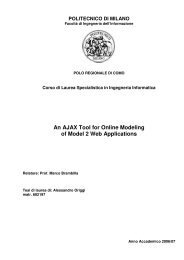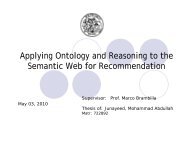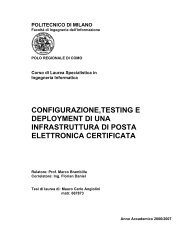Full text preview of the chapter [PDF] - Politecnico di Milano
Full text preview of the chapter [PDF] - Politecnico di Milano
Full text preview of the chapter [PDF] - Politecnico di Milano
- No tags were found...
You also want an ePaper? Increase the reach of your titles
YUMPU automatically turns print PDFs into web optimized ePapers that Google loves.
HEADINGSOCIAL BPM ADOPTION LEVELSThe introduction <strong>of</strong> social features in business processes can be achieved at<strong>di</strong>fferent levels, accor<strong>di</strong>ng to a spectrum <strong>of</strong> possibilities, pictorially illustrate<strong>di</strong>n Figure 1.Fig. 1. The continuum <strong>of</strong> Social Business Process Management.At <strong>the</strong> top <strong>of</strong> <strong>the</strong> spectrum, Closed BPM denotes <strong>the</strong> tra<strong>di</strong>tional approachsupported by state-<strong>of</strong>-<strong>the</strong>-practice BPM suites. The schema <strong>of</strong> <strong>the</strong> process isdecided centrally and deployed to an execution platform (e.g., a BPEL engineor a proprietary runtime). Tasks are defined rigidly, <strong>the</strong> process actors arepreregistered, and allocation <strong>of</strong> actors to task follows statically defined assignmentand escalation rules. The communication among <strong>the</strong> actors ischanneled through <strong>the</strong> task execution interfaces, with <strong>the</strong> exception <strong>of</strong> notifications,which can be delivered through informal channels, like email andSMS.At <strong>the</strong> next level Participatory Design opens <strong>the</strong> process design to multipleactors. Ei<strong>the</strong>r <strong>the</strong> stakeholders can actually participate to <strong>the</strong> definition <strong>of</strong><strong>the</strong> process model or multiple process versions are fused into one sharedprocess model. The latter technique is relevant, for example, after mergerand acquisition, when companies have to align <strong>di</strong>fferent versions <strong>of</strong> <strong>the</strong> sameprocess [LRDtHM11].Participatory enactment shifts <strong>the</strong> focus <strong>of</strong> socialization from design toenactment. Although actors are fixed, as in closed BPM, <strong>the</strong> communicationis not restricted to <strong>the</strong> input and output <strong>of</strong> activities but typical functions <strong>of</strong>social tools are integrated into <strong>the</strong> process enactment application to supportcollateral communications, like following up <strong>the</strong> status <strong>of</strong> tasks, commentingon <strong>the</strong> result <strong>of</strong> task execution, voting on quality <strong>of</strong> service, etc.Social enactment entails opening <strong>the</strong> process execution (at least in part) toactors that are not known at process deployment time and allowing <strong>the</strong> collectiveexecution <strong>of</strong> a task. Social task execution can take a variety <strong>of</strong> forms:from <strong>the</strong> most structured, like <strong>the</strong> use <strong>of</strong> crowd-sourcing platforms for microtasksexecution, to less controlled forms, like community-based productand content rating, cooperative s<strong>of</strong>tware development and testing, etc. The3


![Full text preview of the chapter [PDF] - Politecnico di Milano](https://img.yumpu.com/44021924/3/500x640/full-text-preview-of-the-chapter-pdf-politecnico-di-milano.jpg)









